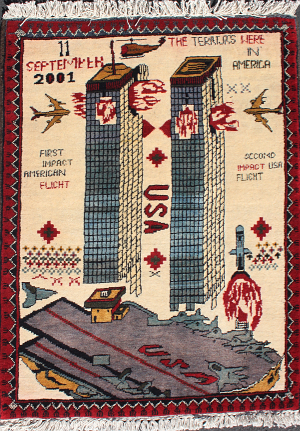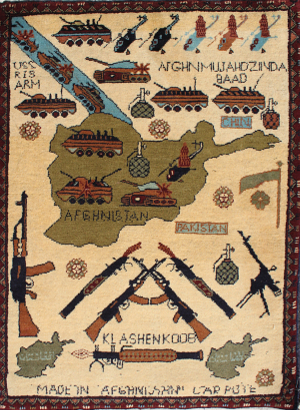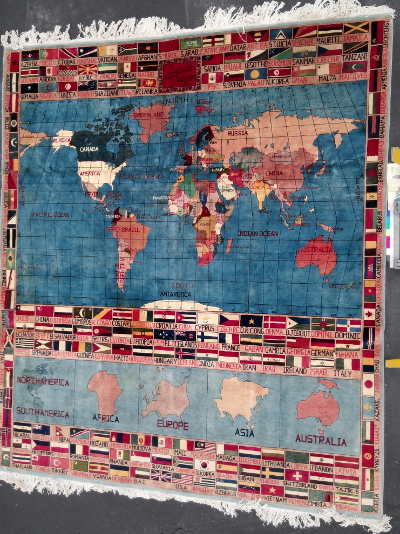| Tower at Jam with Speckled Background War Rug | 30 x 53 inches
76 cm x 135 cm | 136 |
 | WTC no banner. No people jumping war rug | 25 x 32 inches
63 cm x 81 cm | 202 |
| 1990 Dated Prayer War Rug w/Afghan Map Duplicate ID - More info here | 32 x 50 inches
81 cm x 127 cm | 272 |
| Red Rug with Trucks, RPG and Plane Dropped Land Mines | 41 x 64 inches
104 cm x 162 cm | 368 |
| Blue War Rug with Women, Birds, and Small Tanks | 34 x 55 inches
87 cm x 140 cm | 536 |
| War on Terror War Carpet | 25 x 32 inches
63 cm x 81 cm | 555 |
 | Green Najibullah Rug | 24 x 30 inches
61 cm x 76 cm | 773 |
| Early Map Rug with Refugees | 33 x 53 inches
84 cm x 135 cm | 782 |
| NFS - Large Tora Bora | 36 x 60 inches
91 cm x 152 cm | 838 |
| Prayer War Rug | 34 x 57 inches
87 cm x 144 cm | 957 |
| Dual Columns of Tanks and Helicopters | 36 x 60 inches
91 cm x 152 cm | 964 |
| World Map Baluchi Rug with Mir Border | 65 x 108 inches
165 cm x 274 cm | 1004 |
| Massoud Wagireh (weavers sample) Rug with Afghan Map | 29 x 38 inches
74 cm x 96 cm | 1074 |
| Very Fine Pictorial | 32 x 53 inches
81 cm x 135 cm | 1091 |
| Devils Head War Rug | 39 x 60 inches
99 cm x 152 cm | 1382 |
 | Green Amman Ullah Khan Rug | 36 x 58 inches
91 cm x 148 cm | 1421 |
| Red Beljik Rows of Weapons with Rows of Grenades | 24 x 32 inches
61 cm x 81 cm | 1605 |
 | Blue Soviet Exodus War Rug | 22 x 31 inches
56 cm x 79 cm | 1610 |
| New Condition Car Style War Rug | 34 x 55 inches
87 cm x 140 cm | 1635 |
| First War Rug | 39 x 63 inches
99 cm x 160 cm | 1637 |
| Pink RPG Red Rug | 38 x 67 inches
96 cm x 170 cm | 1638 |
 | 2005 Signed Giant World Map Rug Price on request | 107 x 123 inches
272 cm x 312 cm | 1701 |
| Map Foreground WTC Rug | 24 x 32 inches
61 cm x 81 cm | 2101 |